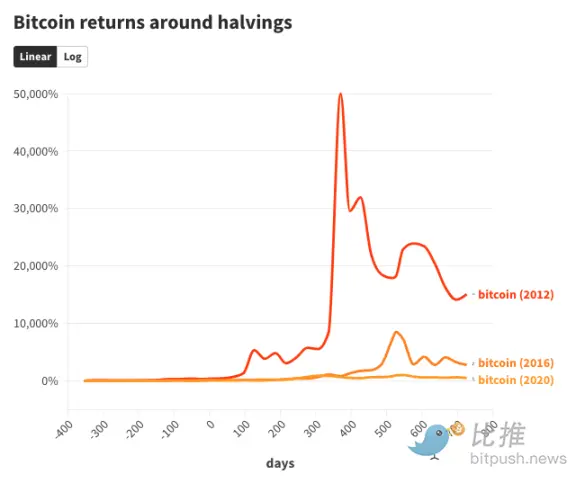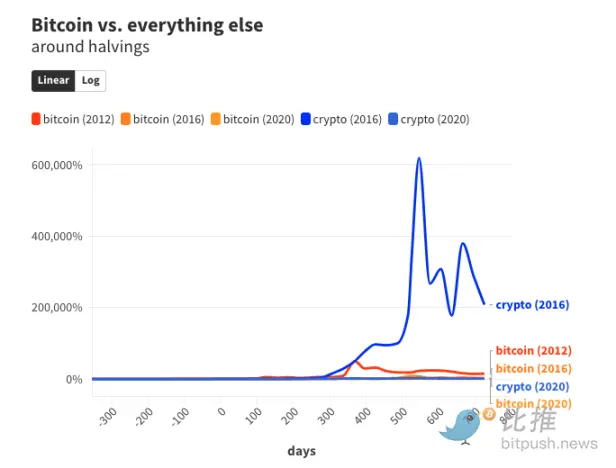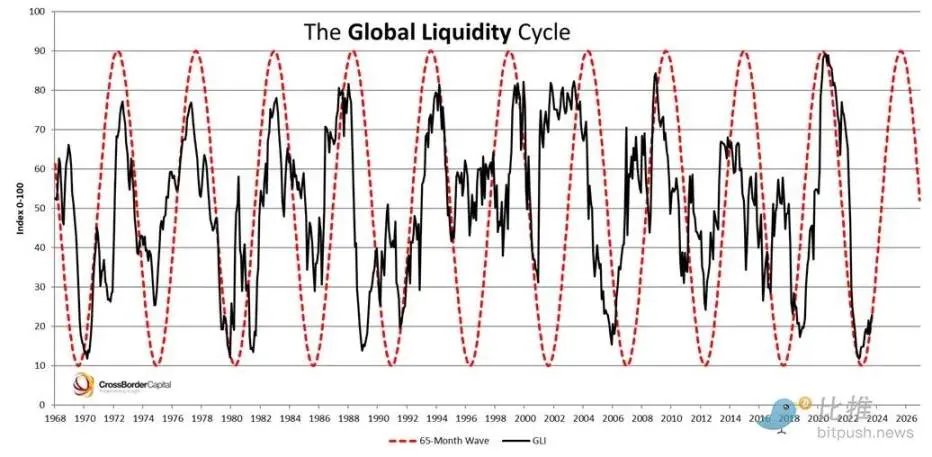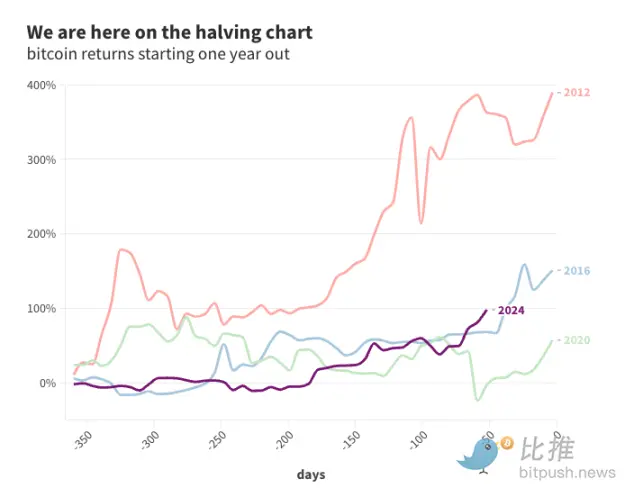Original Title: Bitcoin halvings may be bullish—but returns have shrunk every cycle
Original Author: David Canellis
Original Translator: Mary Liu, BitpushNews
The current rise in Bitcoin is a combination of two bullish narratives: the halving, which will cut the new supply in half in less than eight weeks, and the fact that the pace of inflows into Bitcoin spot ETFs has outstripped the pace of mining.
In addition to the new demand from spot ETFs, halvings are typically seen as a catalyst for a major surge in Bitcoin's price.
However, in the past two cycles, it has been cryptocurrencies in general, rather than Bitcoin specifically, that have benefited the most. The peak gains for Bitcoin from the year before each halving were:
- 50,000% in the year following the 2012 halving.
- 8,500% in the year and a half following the 2016 halving.
- 1,000% in the year and a half following the 2020 halving.
For those with a mathematical mindset, an interesting observation is that the post-halving gains for Bitcoin have been roughly the previous cycle's figure divided by 6 to 8 (50,000%/8,500%; 8,500%/1,000%). If history repeats, then this time Bitcoin's peak gain would be less than 170%—and it has already achieved most of that.

Given that Bitcoin's market cap has now surpassed $1 trillion, all of this is understandable. Bitcoin's price cannot rise 500-fold in two years as it did in 2012 when its market cap was less than $200 million.
Bitcoin (BTC) currently accounts for about half of the entire cryptocurrency market, but there are thousands of other cryptocurrencies, and overall, they tend to "ride the coattails" of Bitcoin's most vigorous rebounds.
In fact, tokens other than Bitcoin have always been able to gain more from Bitcoin bull markets. In the year before the 2016 halving, the total value of cryptocurrencies excluding Bitcoin was $64.9 million.
A year after the halving, during the peak of the 2017-2018 bull market, this figure grew by over 6,000 times to $421 billion, largely thanks to the rise of XRP, Ethereum, and Bitcoin Cash.

Similarly, in the previous cryptocurrency cycle (2019 to 2021), the value of cryptocurrencies other than Bitcoin in the year before the 2020 halving was $71.6 billion.
A year and a half later, when Bitcoin approached its all-time high, the value of all other cryptocurrencies was $1.7 trillion—growing by over 2,000%, surpassing Bitcoin's 1,000% growth rate.
The four-year cycle is not unique to Bitcoin
This article once again emphasizes that the sample size of three halvings is too small to draw any meaningful analysis.
Such a small sample size means that factors outside of halvings may also play a role in shaping what appears to be a regular four-year market cycle for Bitcoin.
Global liquidity cycles track the amount of cash flowing through the global economy, and its correlation with Bitcoin's rise may be even closer than that of halvings.

It turns out that global liquidity also operates on a four-year cycle.
Like halvings, proving that a surge in global liquidity leads to explosive growth in Bitcoin is still unscientific, and it is likely a mix of the two: as global liquidity deepens, supply decreases, spilling over into speculative asset categories such as cryptocurrencies, thereby boosting demand.
Excluding the net outflows from spot ETFs last week, physically-backed Bitcoin funds in the US have been buying nearly 6,350 BTC (worth $362 million) on average per trading day.
Bitcoin miners are currently mining an average of 147 blocks per day, each block yielding a reward of 6.25 BTC (worth $356,600), which is how new coins are distributed across the network.
As a result, miners are extracting less than 920 BTC (worth $52.5 million) from the blockchain each day. Bitcoin funds representing shareholders, led by BlackRock, Fidelity, and Ark/21Shares, have bought nearly six times that amount.
Many aspects of the Bitcoin market exceed the supply of Bitcoin. On average, about 35,000 BTC (worth $2 billion) flow into cryptocurrency exchanges each day, indicating potential Bitcoin sales volumes that are 37 times higher than the daily mining output.

Even considering Bitcoin's recent price surge, if only a small portion of the Bitcoin sent to exchanges is ultimately sold, assuming there is enough supply to meet demand, the price will not immediately skyrocket.
Nevertheless, with the halving approaching—expected on April 19 or 20—it's easy to see how they have captured the imagination of the entire market. Native crypto companies like Bitwise, Bitfinex, and CoinShares have already attempted to unveil their mysterious side, as have financial institutions like JPMorgan and Standard Chartered.
On a practical level, the halving will fundamentally alter the economics of Bitcoin mining. CoinShares expects that if Bitcoin does not stay above $40,000 (which it has so far), several major operators will be in trouble.
Standard Chartered, known in recent years for its bold crypto price predictions, is still maintaining its target of $100,000 per cryptocurrency by the end of this year, in part because of how much the halving may tilt the supply-demand balance.
It's easy to draw a chart of Bitcoin's price movements after previous halvings (there have only been 3, in 2012, 2016, and 2020). After all, Bitcoin's biggest bull markets peaked between one and a half to two years after each halving.
Aside from proving that "past performance is not indicative of future results," everyone is speculating on why this time might be different.
Regardless of whether halvings have (or don't have) an impact on prices, a review of the data shows that while there is a large injection of capital every four years, the cyclical effect on the Bitcoin market is diminishing over time.
免责声明:本文章仅代表作者个人观点,不代表本平台的立场和观点。本文章仅供信息分享,不构成对任何人的任何投资建议。用户与作者之间的任何争议,与本平台无关。如网页中刊载的文章或图片涉及侵权,请提供相关的权利证明和身份证明发送邮件到support@aicoin.com,本平台相关工作人员将会进行核查。




